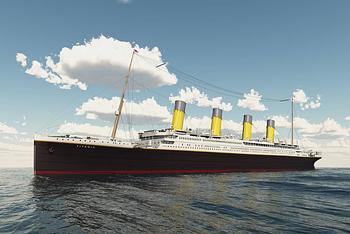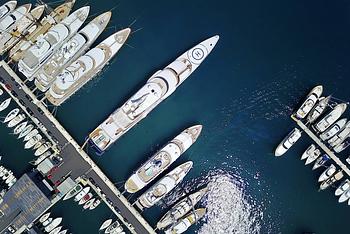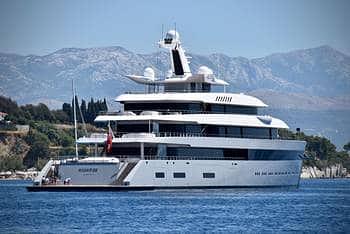The Gulf of Mexico is one of the most ecologically diverse bodies of water and one of the best fishing grounds on the face of the planet, and the portion of the Gulf along the Florida Keys even made our list of the Top 10 Places for Boating in the United States. Try your luck fishing here and along with a wide selection of sportfish you can also expect to see an amazing range of wildlife like dolphins, sea turtles, and countless species of birds. Beautiful beaches, clear blue waters, and thriving reef ecosystems will cap off your angling adventures. Ready to go fishing here? Whether you choose to try deep sea fishing or stay close to the Gulf shores, the types of popular fish to catch can include:
Spanish mackerel. Photo credit: Lenny Rudow
Red Snapper
This is one of the most commonly sought-after fish you can catch and will be found in depths of 20 feet down into hundreds of feet of water. This type of fish is not hard to find even for fishermen with little experience. With a weight that commonly ranges from three to 30 pounds, red snapper live on the Gulf floor around either artificial or natural structures. Regulations regarding catching them vary between state and federal waters and are constantly changing, so check for the latest rule in the specific area you’ll be fishing before you go. The duration of the season also changes each year depending on population assessments.
Grouper
Several different grouper species (gag is the most popular but there are also blacks, Goliath, and more) are usually found at depths of over 50 to 60 feet and sometimes far deeper, around structure located on the Gulf seabed. Some get huge, and the Goliath grouper grows up to 800 pounds. Live bait works effectively for this type of fish. Before heading out, you might want to catch baits first or buy them in your local tackle shop. Grouper is a favorite fish to eat, but like red snapper, regulations and seasons are restrictive and often change from one season to the next.
Wahoo
Wahoo normally weigh between 10 pounds to 100 pounds, with a length of up to six feet. They’re generally located far offshore and may be found around flotsam, structure, or just cruising along looking for a meal. Most are caught while trolling lures or rigged baits with wire leaders to prevent them from biting through the line with their razor-sharp teeth. Aside from being a beautiful game fish, the wahoo is a popular fish for eating as well. Its meaty white steaks can be grilled, baked, or fried making it a favorite catch among many anglers.
Spanish Mackerel
The weight of this fish ranges from one to five pounds, with a length usually ranging from 12 inches to 24 inches. The migration of Spanish mackerel happens annually in the spring and fall. This species is a free swimmer which usually follows schools of baitfish as opposed to sticking close to structure, so most of the time trolling (with small spoons, often pulled behind diving planers) is the best way to catch them. Sometimes, however, they turn the water’s surface frothy in a feeding frenzy and anglers can drive their boats up close, then cast directly into the fray.
Mahi-Mahi
This colorful pelagic species swims open waters far from shore and is constantly on the move. Their size can range quite a bit, and while five to 10 pound fish are common, hooking into 50 pounders or even larger fish is always a possibility. Trolling is an effective way to catch them, but if you spot debris there’s a good chance you’ll also find these fish because they like to enjoy its shade and shelter. Any floating item like a board, a float, or even patches of weeds may have mahi-mahi under it. They often travel in packs so if you catch one keep fishing in the same area, as there’s a good chance many more are nearby.
Tuna
Blackfin, yellowfin, and bluefin tuna can all be found in these waters. Blackfin are the smallest and a 30 pounder is considered huge, yellowfin can reach a few hundred pounds, and while bluefin are the rarest tuna around here they can reach epic proportions—a handful topping the 800-pound mark have been recorded. Each type of tuna occupies a slightly different niche, but fishing around far-off oil rigs is the most common way of targeting them in the Gulf. Live-baiting, chunking, and trolling are all methods anglers may employ. Note that large specimens of these fish require heavy-duty gear and lots of know-how to get into the boat.
King Mackerel
These fish, often called “kingfish,” can grow to push the 100-pound mark, though the vast majority caught by anglers range from five to 30 pounds. They are fished using live baits, trolling with spoons, and sometimes by slow-trolling rigged baits like cigar minnows or ribbonfish. They’re toothy critters that can bite through monofilament so the use of wire rigs is critical if you want to catch a kingfish.
Sharks
Many species of sharks live in the Gulf, with the common types usually encountered including tiger sharks, bull sharks, and hammerheads. Mako may also be caught depending on the time of the year. The size of the sharks in the Gulf of Mexico typically measure up to 10 feet, with some growing even larger. Most sharks are released after being caught since they aren’t good to eat, except for those makos. That species, however, is tightly regulated and currently anglers aren’t allowed to keep them at all.

Dusky shark. Photo credit: Lenny Rudow
Vermillion Snapper
The size of these fish (also called “beeliners”) at an average of one to five pounds, plus their abundance, makes them an easy catch even for kids of any age. They live around the reefs and are a phenomenal fish to eat all year round. Locals often prefer vermillion snappers on their plate over just about any other fish. Most anglers targeting them will anchor upcurrent of a reef and drift back cut baits in a chum slick. When a school moves in, the action can be fast and furious.
Grey Triggerfish
This fish may appear ugly with a small mouth that has buck teeth and a compressed flat body, but they are great to eat. You can find this species around reefs, wrecks, and sometimes in open water hiding under flotsam. Anglers use squid bits on very small hooks to catch them. The real challenge, however, is cleaning them. Triggerfish are armored with very tough, rugged scales, which will turn a knife dull after fileting just a few fish. Tip: to get them to flatten out the sharp, spike-like front dorsal, press back the second dorsal spike—the fish’s “trigger.”
Amberjack
With a weight averaging from 20 to 40 pounds, with fish sometimes weighing even more than 100 pounds, fishermen consider these species to be some of the hardest fighting fish they catch all year round—you need to have strong arms to get them into your boat. Fishermen call them “reef donkeys” because they live around reefs and display an amazing stubbornness on the end of the line. You can find Amberjack on artificial reefs with depths ranging from 60 to 400 feet, and catch them using live bait or jigs. These fish aren’t favored for food and few people keep and eat them, but catch-and-release anglers love them for the fight.
Crevalle Jack
Also called Jack Crevalle or simply “jacks,” these fish are often found around offshore wrecks, reefs, or near inlets. They can weigh from 10 to 12 pounds on average but larger fish can top 50 pounds. Anglers use fresh live baits in fishing them out. Most of the meat of these fish is dark red with a strong flavor, making it the least favorite by most palates, so these jacks are usually released after the fight.
Sheepshead
This species earned its other name, the “convict fish,” because of its black vertical bands that look like a striped jumpsuit. It also has massive protruding teeth, which it uses to crush a shellfish diet consisting of shrimp, crabs, mussels, and barnacles. As a result of this diet, sheepshead taste great and are considered among the best fish around in food value. They can be found in rocky areas along the coast as well as around reefs and wrecks offshore. Although most only weigh a few pounds and a 10 pounder is a trophy, sheepshead can be really tough during the fight.
Red Drum
Red Drums usually have a bronze or reddish color with a white underside. They commonly weigh between three and 10 pounds, but large “bull reds” sometimes reach up to 50 pounds or more. They can often be found along shell bars, shallow flats, and rocky or grassy shorelines. This species is incredibly popular among anglers, and has a number of different nicknames such as redfish, slot fish (for those falling into the “slot” size where harvesting them is allowed), puppy drum or rats (for smaller fish), and channel bass. They have an insatiable appetite and will take live baitfish, shrimp, and crabs.
Flounder
These fish lie on the bottom on their side due to their laterally compressed bodies. They also have a brown or olive color with spots and can weigh from one to three pounds on average, sometimes reaching up to 10 or more pounds. Highly prized as food fish for their white and mild meat, baits like live or dead shrimp, cut fish, and especially finger mullet, work for them.
Cobia
Cobia commonly weigh from 20 to 50 pounds, and can grow to more than 100 pounds. Their color is brown or dark gray above with a white underside that makes them look like sharks when viewed from above the water’s surface. They are prized for their taste, and since they can be spotted while lazing at the surface, many anglers like to sight-fish for them.
Cobia. Photo credit: Lenny Rudow
Tarpon
Tarpon, called the “silver king,” are some of the most sought-after gamefish around. They aren’t good to eat but they leap into the air when hooked and fight like few fish can. They also get big—very big—with some specimens weighing several hundred pounds. A migratory fish, tarpon can only be targeted during certain seasons in certain places.
Going Fishing in the Gulf of Mexico
There are plenty of skilled and experienced local fishermen that offer guided fishing trips in the Gulf of Mexico. Both walk-on and chartered trips are available, which can work for families, friends, or even corporate getaways. Booking charters such as these will mean the professionals take care of providing tackle, bait, and fishing boats that will make your experience seamless and enjoyable.




